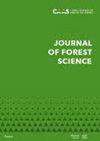捷克共和国针叶林灾害背景下的原材生长量现状和进一步发展的预测
IF 1.1
Q3 FORESTRY
引用次数: 0
摘要
由于全球气候变化的影响,随之而来的是树皮下害虫(主要是针叶林)的蔓延和持续的偶然砍伐,灾害的急剧发展引起了木工行业对原材料发展的关注,以确保短期内的生产。由于捷克共和国所有年龄级云杉林的总蓄积量为3.996亿立方米(2017-2026年),基于采伐百分比的采伐潜力理论前景为1.1262亿立方米(2017-2026年),因此这些担忧可能被认为是合理的。这篇文章根据官方统计资料提出了对目前情况的最新看法,并考虑到可能的后果,甚至在林业部门的生产方面,对可能的发展作出了分析性预测。关于目前情况的统计数据是根据过去二十年的发展汇编的。结果表明,在树皮甲虫灾害率持续高的情况下,假设每年总采伐量永久限制在3000万m3以上的计划采伐量,5级以上云杉的完整林分大约可以在14-16年内采伐完。本文章由计算机程序翻译,如有差异,请以英文原文为准。
State of the raw wood growing stocks and prediction of further development of cutting in the context of coniferous stands calamity in the Czech Republic
The extremely dynamic development of calamities caused by the effects of global climate change followed by the spread of under-bark insect pests mainly in coniferous stands and the ongoing incidental felling have raised concerns in the woodworking industry about the developments in the source material with respect to ensuring production in a short-term view. Since the overall standing stock in spruce stands of all age classes in the Czech Republic amounts to 399.6 million m3 (2017–2026) and the theoretical outlook of the logging potential based on the percentage of logging accounts for 112.62 million m3 (2017–2026), the concerns might be deemed justified. The article presents an updated view of the current situation based on official statistics and offers an analytic prediction of the possible development, considering the possible consequences, even in the production of the forestry sector. The statistical data on the current situation have been compiled for the last two decades of development. The results show that with a continued high rate of bark beetle calamities, assuming a total annual cutting with a permanent limitation on the planned harvests of more than 30 million m3, the complete stands of spruce from age class 5 onwards could be harvested in approximately 14–16 years.
求助全文
通过发布文献求助,成功后即可免费获取论文全文。
去求助
来源期刊

Journal of forest science
Forestry-
CiteScore
2.30
自引率
9.10%
发文量
48
审稿时长
6 weeks
期刊介绍:
Original results of basic and applied research from all fields of forestry related to European forest ecosystems and their functions including those in the landscape and wood production chain are published in original scientific papers, short communications and review articles. Papers are published in English
 求助内容:
求助内容: 应助结果提醒方式:
应助结果提醒方式:


